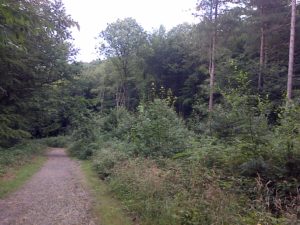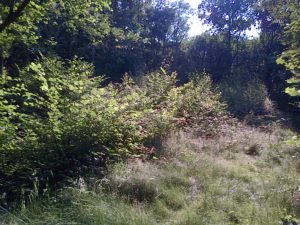The White Admiral (Limenitis camilla), a very uncommon species in London, with reports from only 3 sites as recently as 2014, has this week been confirmed as present in the Borough of Bexley. Previous reports from Joyden’s Wood and nearby pointed strongly to this possibility, but with the Bexley/Dartford (London/Kent) boundary passing through the woodland itself, previous observers had been unable to confirm which side of the line their sightings had been made on. It has been an objective of wildlife recorders in the area to clarify the matter during this butterfly season.
Steve Carter had seen a White Admiral in Joyden’s Wood on July 18th and reported it on the ‘Bexley Wildlife’ Facebook page. When quizzed he gave an approximate grid reference which appeared to put him on the main path heading south-east from the Keeper’s Cottage, and was within Bexley. Armed with this information, Bexley Butterfly and Moth Group’s Joe Johnson, Mike Robinson and Chris Rose went in search of further sightings in this area on Saturday July 23rd. In the meantime, Mike had photographed one at the Parsonage Lane end of the wood on July 21st, believing that this too was inside the Bexley boundary.
The weather was somewhat changeable, with periods of no sun, then butterflies taking to the air as soon as it came out again. But we were in luck, seeing a White Admiral in the first area of young coppice by the side of the path that we came to, well within the Bexley boundary. Having never seen one before, it was surprising just how pale this ostensibly black insect appears at a distance when flying in sunlight, a bit like a ‘White’, but not quite.
A White Admiral Butterfly visits Brambles in Joyden's Wood ~ 21 July 2016 pic.twitter.com/ejc50TgsBp
— Mike Robinson (@MikeFRobinson) July 21, 2016
A few Silver-washed Fritillaries were also seen utilising these recently coppiced areas, a species confirmed as a Bexley resident by Joe only last year, following the same issues over pinpointing the precise position of other sightings of it in relation to the Borough’s border.
A Silver-Washed Fritillary Butterfly rests in Joyden's Wood (LB of Bexley or Kent) ~ 23 July 2016 pic.twitter.com/hGyCNBzwhB
— Mike Robinson (@MikeFRobinson) July 23, 2016
A Silver-Washed Fritillary Butterfly visits Hogweed in Joyden's Wood (LB of Bexley) ~ 23 July 2016 pic.twitter.com/v46IqICutM
— Mike Robinson (@MikeFRobinson) July 23, 2016

Recently coppiced clearings beside pathways are providing ideal habitat for White Admiral, Silver-washed Fritillary and other butterfly species in Joyden’s Wood (Photo: Chris Rose)
After Mike and Joe went off elsewhere, Chris headed south along the western margin of the wood towards Parsonage Lane. He saw another White Admiral and a Silver-washed Fritillary flying over the main ride and the lower vegetation on its north side, just beyond the end of the lane and adjacent to Chalk Wood. As far as can be deciphered from the available maps, the Bexley/Kent border runs along the ride itself at this point. Ralph Todd and Ian Stewart had reported seeing a White Admiral at some unspecified point along the margin of Chalk Wood in 2015.
Chris was even more pleased to find 2 White admirals in Gatton’s Plantation, a site he’d never visited before, and which is wholly within Bexley. This rather validates the 2003 record of the species made here by top botanist Mark Spencer, but which the London biodiversity records centre (GiGL) has classed as ‘unverified’. The woodland here is extremely dense, but with a surprisingly good groundcover. There are, however, three clearings, two better than the other, and in each of these latter one of these insects was intermittently active. At one point the first one encountered landed on some damp mud only about three feet in front of him, but he couldn’t react quickly enough to grab a photo and it was off again. The second of them was still flying at 18.17, though by this time only the east end of its clearing was still in sunshine. There was no sign of Fritillaries here, though the larval foodplant – violets – was present.
A map showing the locations of White Admiral and Silver-washed Fritillary sightings on July 23rd appears below:
The next challenge is to see whether the range of either or both species extends further into Bexley, for example at North Cray Wood, Churchfield Wood or even Braeburn Park. The habitat in the former of these looks less promising than in the latter two.
In addition, there are also claims of Brown Hairstreak at Lesnes and in the Woodlands Farm area to be investigated ……
(Chris Rose)

